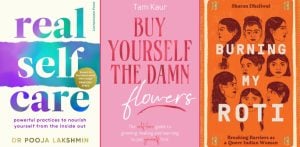"I was initially scared, disgusted but eventually intrigued."
The acronym for BDSM stands for B/D (Bondage and Discipline), D/s (Dominance and submission), and S/M (Sadism and Masochism).
It says very little when it comes to the letters but encompasses a wide and diverse community – including Asmi, a practitioner of a BDSM submissive lifestyle.
BDSM serves as a catch-all phrase for a great number of subcultures and types of relationships. Most recently, it’s number one association is with the erotic romance novel and subsequent film, Fifty Shades of Grey.
The popularity of Fifty Shades of Grey may have lessened the taboo around BDSM for mainstream audiences. Nevertheless, a significant amount of criticism suggests that the central relationship is more abusive than consensual.
Contrary to popular belief, the dynamic of the couple is not the standard or something to “cure”. Inclusive of all genders, nationalities, sexualities and class, there’s a variety of relationships in the community, which can be sexual or non-sexual in nature.
But what better way of highlighting the diversity of this community than speaking to one of its members?
In her early 30s, Delhi-based Asmi is an Indian BDSM submissive, identifying as a lifestyle submissive.
DESIblitz speaks to Asmi about her own journey, her experiences, her various communities including the myths concerning them.
Tell us about your journey into BDSM
I was aware of my submissive side in a very non-sexual way, even at an early age.
While I didn’t clearly come out to anyone (I didn’t even know there was something to come out about), I do remember a conversation with one of my teachers about how I felt like I needed to submit to the authority of my parents, teachers, seniors, or eventually my husband and his family.
I also remember that my teacher tried to tell me that I wasn’t a submissive person because I was this performer, leader, speaker, writer, orator, topper and the rest. They also told me to be wary of guys and feared I may be taken advantage of.
I do also remember telling them to explain to me about what kind of advantage they mentioned. They just stopped at saying: “young girls must be careful and protect their dignity”.
For the longest time after that, I did not consciously think about that. However, there was something common in my interpersonal interactions. I preferred being around people with authority and yet I found myself obeying only people I trusted and respected.
I think the relapse of my self-identified submission happened again when I was dating a guy long-distance.
He was what I would, in hindsight, call a control freak. Back then, I didn’t know better. We broke off after meeting a few times. Then the inexperienced naïve me was depressed at the loss of a relationship.
Again, in hindsight, I realise it had more to do with the lack of control and structure.
I had moved to Delhi by then and had taken up my first job. Here, another woman who worked with me, introduced me to porn, thinking that my relationship was a full-blown relationship and that it was perhaps the sexual dissatisfaction that was upsetting me.
Little did she know that I had never been intimate with anyone in my life.
In my attempt to watch porn, I got exposed to a kink website – I no longer remember the name, more because I’m not much of a graphic or visual person, but more of a literal or reading person.
I was initially scared, disgusted but eventually intrigued. As I started researching I realised that I had finally found some terms that made sense and gave meaning to how I felt but hadn’t been able to articulate.
My research led me initially, to the online communities, mainly abroad. And then to the small, loosely structured, but close-knit Indian community.
For 3 years, I didn’t experiment physically.
I did that only once there was some pressure related to marriage because I wanted to be very sure of what I would be getting into, in the name of marriage.
Then on, it’s been a long journey.
What does being a Lifestyle Submissive mean?
People who practice BDSM and/or kink, engage in it on multiple levels.
Some of them do it only in the bedroom, some of them submit to a partner even outside the bedroom, and others stretch it all the way to full control over mind, body, time, social relationships and/or money.
Anyone who does it more than just a sexual practice and is keen on engaging in it outside the bedroom is loosely called a lifestyle practitioner.
In my personal case, I am a submissive through and through in a relationship. That said, I am not really servile or submissive to the extent of inner slavery.
So, when I say I am a lifestyle submissive, something like this example is what my day would be:
- Wake up, brush, shower, dress up
- Cook and eat breakfast with my partner
- Go to work
- Come back
- Discuss the day
- Eat dinner together
- Sleep
Now one may ask how is it different from anyone else’s day. Well, I usually prefer to cook what my partner likes as long as it is vegetarian food. I like to dress based on their wishes.
There are these tiny little updates I will share with them – not the mushy-romance of Fifty Shades of Grey kind of love or sexts, not that they are bad!
The end of the day discussion for us is more formal and structured.
When I’m alone with my partner, I like to kneel with them, rather than sit next to them. If we cuddle, I am very happy with a naked submissive, clothed Dominant situation.
A look of disappointment from a dominant partner can cause me to tear down.
I like to use my honorifics throughout – Sir, Master, Ma’am, Mistress or whatever – not just in the bedroom.
Now compare this with:
My partner goes on with their day. I go on with mine. We come back, cook and eat, and then directly to the bedroom, some bondage, some pain, some sex and the next morning both choose to be equals.
What are the Top Myths about BDSM?
My choice to be a lifestyle submissive doesn’t come from any comparative bias.
I just prefer long-term, more involved, day-to-day, invested relationships with an undercurrent of Dominance/Submission. I am really not attracted that much to physical activities like pain, or sex or bondage.
To me personally, sex and arousal are by-products. I first have to be able to accept a partner as my leader, mentor and guide in life.
This is not to say that those who explore BDSM only in the bedroom, are better or worse. Some lifestyle practitioners tend to think one nuance is better than the other. No, it’s not, They are just nuances.
However, none of this happens because I am weak or incapable of leading a fully functional life by myself. For the longest time of my life, I was a single woman. I am single currently for instance.
Just because I am a submissive, doesn’t mean that I am dependent on a Dominant to function. It just means that there is a natural inclination for structure and loving control coming from someone consensually and respectfully.
Submissives are not weak people and male submissives are not sissies or hen-pecked husbands. We are usually accomplished, self-respecting people, who choose to follow a leader in our personal lives, when we find one.
Not all Dominants are abusers or bullies, or sex maniacs, or control freaks. Sadism is not the same as Domination. Kinky people are not all polyamorous and promiscuous. BDSM is not just about rough sex.
Safety is everyone’s responsibility – the Dominant’s as well as the submissive’s. Dominants can also have and use their safe word.
I don’t know how many myths I could list but these are some of the top ones.
You later discovered you were polyamorous and identify as queer. How would you describe your experience of navigating these various communities?
I would say, I am uncomfortable with how polyamory is misunderstood and hence people’s expectations can be fairly misplaced when it comes to a woman saying that she is inclined to be polyamorous.
I do see lots of similarities between the LGBT and BDSM communities. However, I think that LGBT people sometimes get overexcited and try to override other forms of sexual expression, which can sometimes cause resentment among people.
But like, in any social dynamic, all these communities have people who are ethical, sorted and people who are confused, or sometimes even manipulative or malicious. The general dynamics of all communities, even the mainstream, vanilla, heterosexual, monogamous community for that matter.
That said, my personal experiences with communities have generally been positive.
Has it been a Positive BDSM experience for You?
Overall, yes, very positive. The community is small. It has grown since Fifty Shades of Grey.
But a lot of people do not really understand it. There are misconceptions. Men tend to seek an easy lay under the pretext of BDSM. I get so many messages, which begin with “kneel bitch” and 5 messages later, evolve into “beg you to accept me as your dog Mistress”.
That said, I have met seasoned, ethical practitioners. I have met people who genuinely have helped me not just in the lifestyle, but in life, I have come across friends who have now become family.
I have experienced an entire spectrum of human emotions, my own sexuality and thoughts here and have mostly been encouraged to explore deeper.
Your top tips for a Safe and Consensual BDSM Session?
Read and talk. Read non-fiction. Talk with those who are experienced and even those who are not. Discuss with Dominants, Submissives, Switches and the rest alike. Read and discuss with your partner.
Did I say read and discuss and talk?
Now that I’ve said it, my top tips:
Negotiate in detail. Even if it is an effort, it takes, time, energy, sounds like transactional, rather than organic, do it. It can save your life.
Talk about issues like diabetes, hypertension, palpitations, epilepsy.
I once had someone who told me during the session that they had a high blood pressure, not when we were negotiating. I discovered, only because I felt they were palpitating and I had to call the session off midway.
Don’t play without meeting at least a few times in public. A safe call helps. Safe words are a must.
Aftercare is important. Anyone who doesn’t understand these concepts, educate them first. Don’t play if they treat safety lightly.
Take it slow. It’s easy to get carried away, do things under substance abuse – something as simple as alcohol or weed.
There are people who do full substance trips. I have never endorsed them. I may have played under the influence of alcohol a couple of times early on, when I used to drink, but I have learnt better. It’s a bad idea most of the time.
Don’t accept bullying behaviour, manipulation or abuse. While there’s no way to ensure that it will NEVER happen – let’s accept it, the lifestyle comes with its risks. However, safety is better than shit. So, if your gut says something, listen to it. Please.
Hygiene. I shouldn’t have had to say this, but toys, body, clothes, gear needs to be cleaned well, especially when people are playing with multiple people.
Watch out for each other’s bodies and minds and respect the safe words as sacrosanct, irrespective of who uses it, whether a Dominant or a submissive.
The biggest tip is common sense. Eventually, that’s what everything is going to boil down to.
Do you have Any Fetishes?
I am not really sure if I have what is commonly defined as fetishes as I have shared in one or one or two of my previous answers.
I am really not driven by sex or pleasure or orgasms. So while I do have things that I like to do with my partner they are very day-to-day activities that do not necessarily classify as fetishes.
That said, most of my fetishes revolve around structure, discipline, dominance and submission.
Also, I think over years I have realised that pain of consensual nature and responsibly administered, is something that helps me feel centred.
Think of it like a very intense workout at the gym rather than thinking of it as domestic violence.
Is BDSM empowering?
Personally, the dominance and submission that I have engaged in, has empowered me a lot. The structures have helped me to find external motivation when circumstances held me down heavily.
Being able to submit to somebody’s authority was helpful to me when I found too much inertia around an activity I wanted to do or a goal I wanted to achieve.
I think others can also benefit from it. However, I think that two things are necessary.
The Dominant has to be really responsible and the submissive willing to work on their issues, goals, aspirations. A Dominant/Submissive relationship is not a substitute for lack of will, or manipulation or a dysfunctional and irresponsible life.
Also, it’s not a substitute for therapy. I think one of the problems that people can have when trying to empower or be empowered through a Dominant/Submissive relationship is co-dependence and too much evangelising of the lifestyle.
Are you comfortable sharing your BDSM lifestyle?
It wasn’t an easy journey. It was also a long one. I had always believed that my parents and my family would eventually be able to understand, at least in theory, the intricacies of my lifestyle.
However even before I discovered the lifestyle, my parents were always open to answering what could be a controversial question.
Coming from a tier 3 city in India, when I asked them about my options of getting married in a different caste, or a different community, or a different country, I found them very non-judgemental.
I would generally expose them in a theoretical and academic manner, to concepts like LGBT or polyamory or other discussions about sexuality.
Slowly, I came out to my siblings in a casual manner and then after I wrote my first book and gave my first talk, I knew it was time to come out to them.
It was easier with friends as some of them were already from the community. Most of my friends who really matter have chosen to accept me for who I am.
They have asked questions, made an effort to understand, they have been concerned, watched out for me, but haven’t judged or embarrassed or humiliated me.
The rest don’t really matter.
And why should they? As Asmi points out all communities have members who behave unkindly or unfairly.
Although prejudice towards the BDSM community can be due to a lack of knowledge, Asmi highlights the harm of generalising a group of people.
Indian BDSM submissive Asmi has provided an insightful look into a portion of a much wider group. Thanks to her personal story, we can learn about a percentage of people, that often for their protection, remain anonymous.
Films like Fifty Shades of Grey may have brought the concept of BDSM to the public. However, for the sole mainstream depiction of an already misunderstood community to be negative seems particularly unfair.
Indeed, learning about the stories of others is advantageous not only for the minority community but could be for wider society too.
As Asmi has shown and a quick perusal through certain BDSM sites and online media demonstrate, discussions around consent are arguably more forward-thinking than in wider, heterosexual and “vanilla” society.
Therefore, it’s great to learn why Asmi is an Indian BDSM submissive but also why we should encourage free and open discussion for the benefit of all.



































































